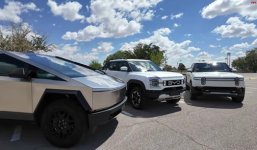tesla 1
Member
The BYD (Build Your Dreams) Shark is a futuristic electric pickup truck concept that could potentially challenge American heavyweights like the Tesla Cybertruck and Rivian R1T. While still in its early stages and not as widely available as its competitors, comparing these vehicles can give insights into how the Chinese-built Shark might stack up against the Tesla Cybertruck and Rivian R1T, especially in terms of innovation, performance, and practicality.
News and Updates
As of now, the BYD Shark is in the concept stage, and limited information is available about production timelines or specific markets. It is expected to launch within the next few years as part of BYD’s push into the electric pickup segment.
BYD has been making waves in the EV market with its advanced battery technology and strong presence in the Chinese market, and the Shark is expected to expand its portfolio into larger vehicles like trucks.

Size and Dimensions
BYD Shark: Official dimensions have not been fully disclosed yet, but the Shark is expected to be slightly smaller than the Cybertruck but larger than mid-size pickups, putting it in the same category as the Rivian R1T.
Likely dimensions:
Length: Around 230 inches
Width: 78-80 inches
Height: 70-75 inches
Tesla Cybertruck:
Length: 231.7 inches
Width: 79.8 inches
Height: 75 inches
Rivian R1T:
Length: 217.1 inches
Width: 79.3 inches
Height: 78.1 inches
While the BYD Shark’s exact size is unknown, it is expected to be a full-size truck, similar to the Cybertruck and R1T. The Shark may offer slightly more compact dimensions compared to the Tesla Cybertruck.
Battery and Range
BYD Shark:
BYD is known for its Blade Battery technology, which is highly regarded for its safety and energy density.
Battery Size: The Shark could feature a 100-120 kWh battery.
Range: Estimated to have a range of 300-400 miles on a full charge, depending on the configuration and conditions.
Tesla Cybertruck:
The Cybertruck offers multiple battery options, with the top-tier variant featuring a 200+ kWh battery.
Range: Estimated range of up to 500 miles for the tri-motor version.
Rivian R1T:
The R1T comes with a 135 kWh battery pack in its higher trims.
Range: Offers an electric range of around 314 miles, with potential future versions expected to exceed 400 miles.
In terms of battery capacity and range, the Cybertruck has a significant advantage with its long-range tri-motor model, while the R1T offers a solid mid-range. The BYD Shark is expected to slot in between, with a competitive range likely comparable to the base Cybertruck or R1T, but without the extreme 500-mile range of Tesla’s top model.
Performance (0-100 km/h)
BYD Shark: Early performance estimates suggest a 0-100 km/h (0-62 mph) time of around 4.5 to 5.0 seconds, depending on motor configuration.
Tesla Cybertruck:
The tri-motor version of the Cybertruck can go from 0-100 km/h in 2.9 seconds, making it one of the fastest pickup trucks ever.
Rivian R1T:
The Rivian R1T has an impressive 0-100 km/h time of 3 seconds.
While the BYD Shark is expected to deliver strong performance, it will likely not match the supercar-level acceleration of the Cybertruck or Rivian R1T, especially the tri-motor and quad-motor setups.
Seats and Interior
BYD Shark: Seating for 5 passengers with a focus on a modern, tech-forward interior similar to other BYD vehicles. Expect high-quality materials, a minimalist dashboard, and large screens for infotainment and vehicle controls.
Tesla Cybertruck: Seats up to 6 passengers, with a minimalist interior, a 17-inch touchscreen, and futuristic materials like stainless steel accents.
Rivian R1T: Seats 5 passengers with a luxury feel, using vegan leather, wood trims, and a large 16-inch infotainment screen. The R1T also has a unique gear tunnel for extra storage.
The Shark’s interior will likely focus on comfort and technology, but it remains to be seen if it can match the premium finishes and innovative storage solutions of the R1T or the futuristic minimalism of the Cybertruck.
Advantages of the BYD Shark
Battery Technology: BYD’s Blade Battery is known for safety and efficiency, potentially making the Shark one of the safest electric trucks on the market in terms of thermal management.
Price: BYD is known for offering competitive pricing in the EV market, and the Shark could be priced lower than both the Cybertruck and Rivian R1T. Expected prices could start around $60,000-$70,000, which would undercut the top-tier versions of both rivals.
Chinese Manufacturing Expertise: BYD has massive manufacturing capacity and expertise in electric vehicles, which could allow them to offer a more affordable and reliable truck with fewer delays in production.
Sales and Market Presence
BYD Shark Sales in the USA and Europe: Since the Shark is not yet on the market, it’s difficult to assess sales potential. BYD has announced plans to expand its presence in Europe and possibly the U.S., but it will face strong competition from established brands like Tesla and Rivian.
Tesla Cybertruck: Expected to be one of Tesla’s best-selling vehicles, with over 1 million pre-orders as of recent reports. The Cybertruck will likely dominate the U.S. market, given Tesla’s strong presence and fan base.
Rivian R1T: Already available and making waves in the electric truck market, Rivian has positioned itself as a serious competitor, particularly in the adventure and outdoor enthusiast segments. Sales are growing steadily, and Rivian has already entered the U.S. market with strong demand.
Conclusion
The BYD Shark has the potential to be a competitive player in the electric pickup truck segment, especially with its advanced battery technology and likely lower price point. However, it faces stiff competition from the Tesla Cybertruck and Rivian R1T, which offer stronger brand recognition, more powerful performance, and a proven track record in EV manufacturing.
The Cybertruck is the leader in terms of raw power, range, and futuristic design.
The Rivian R1T excels in luxury, off-road capabilities, and practicality for outdoor enthusiasts.
The BYD Shark could emerge as a cost-effective, high-tech alternative, especially for buyers looking for an affordable yet futuristic electric truck.
However, the Shark’s success will depend on how well BYD can penetrate Western markets and deliver on its promises of performance and affordability.
Youtube
News and Updates
As of now, the BYD Shark is in the concept stage, and limited information is available about production timelines or specific markets. It is expected to launch within the next few years as part of BYD’s push into the electric pickup segment.
BYD has been making waves in the EV market with its advanced battery technology and strong presence in the Chinese market, and the Shark is expected to expand its portfolio into larger vehicles like trucks.

Size and Dimensions
BYD Shark: Official dimensions have not been fully disclosed yet, but the Shark is expected to be slightly smaller than the Cybertruck but larger than mid-size pickups, putting it in the same category as the Rivian R1T.
Likely dimensions:
Length: Around 230 inches
Width: 78-80 inches
Height: 70-75 inches
Tesla Cybertruck:
Length: 231.7 inches
Width: 79.8 inches
Height: 75 inches
Rivian R1T:
Length: 217.1 inches
Width: 79.3 inches
Height: 78.1 inches
While the BYD Shark’s exact size is unknown, it is expected to be a full-size truck, similar to the Cybertruck and R1T. The Shark may offer slightly more compact dimensions compared to the Tesla Cybertruck.
Battery and Range
BYD Shark:
BYD is known for its Blade Battery technology, which is highly regarded for its safety and energy density.
Battery Size: The Shark could feature a 100-120 kWh battery.
Range: Estimated to have a range of 300-400 miles on a full charge, depending on the configuration and conditions.
Tesla Cybertruck:
The Cybertruck offers multiple battery options, with the top-tier variant featuring a 200+ kWh battery.
Range: Estimated range of up to 500 miles for the tri-motor version.
Rivian R1T:
The R1T comes with a 135 kWh battery pack in its higher trims.
Range: Offers an electric range of around 314 miles, with potential future versions expected to exceed 400 miles.
In terms of battery capacity and range, the Cybertruck has a significant advantage with its long-range tri-motor model, while the R1T offers a solid mid-range. The BYD Shark is expected to slot in between, with a competitive range likely comparable to the base Cybertruck or R1T, but without the extreme 500-mile range of Tesla’s top model.
Performance (0-100 km/h)
BYD Shark: Early performance estimates suggest a 0-100 km/h (0-62 mph) time of around 4.5 to 5.0 seconds, depending on motor configuration.
Tesla Cybertruck:
The tri-motor version of the Cybertruck can go from 0-100 km/h in 2.9 seconds, making it one of the fastest pickup trucks ever.
Rivian R1T:
The Rivian R1T has an impressive 0-100 km/h time of 3 seconds.
While the BYD Shark is expected to deliver strong performance, it will likely not match the supercar-level acceleration of the Cybertruck or Rivian R1T, especially the tri-motor and quad-motor setups.
Seats and Interior
BYD Shark: Seating for 5 passengers with a focus on a modern, tech-forward interior similar to other BYD vehicles. Expect high-quality materials, a minimalist dashboard, and large screens for infotainment and vehicle controls.
Tesla Cybertruck: Seats up to 6 passengers, with a minimalist interior, a 17-inch touchscreen, and futuristic materials like stainless steel accents.
Rivian R1T: Seats 5 passengers with a luxury feel, using vegan leather, wood trims, and a large 16-inch infotainment screen. The R1T also has a unique gear tunnel for extra storage.
The Shark’s interior will likely focus on comfort and technology, but it remains to be seen if it can match the premium finishes and innovative storage solutions of the R1T or the futuristic minimalism of the Cybertruck.
Advantages of the BYD Shark
Battery Technology: BYD’s Blade Battery is known for safety and efficiency, potentially making the Shark one of the safest electric trucks on the market in terms of thermal management.
Price: BYD is known for offering competitive pricing in the EV market, and the Shark could be priced lower than both the Cybertruck and Rivian R1T. Expected prices could start around $60,000-$70,000, which would undercut the top-tier versions of both rivals.
Chinese Manufacturing Expertise: BYD has massive manufacturing capacity and expertise in electric vehicles, which could allow them to offer a more affordable and reliable truck with fewer delays in production.
Sales and Market Presence
BYD Shark Sales in the USA and Europe: Since the Shark is not yet on the market, it’s difficult to assess sales potential. BYD has announced plans to expand its presence in Europe and possibly the U.S., but it will face strong competition from established brands like Tesla and Rivian.
Tesla Cybertruck: Expected to be one of Tesla’s best-selling vehicles, with over 1 million pre-orders as of recent reports. The Cybertruck will likely dominate the U.S. market, given Tesla’s strong presence and fan base.
Rivian R1T: Already available and making waves in the electric truck market, Rivian has positioned itself as a serious competitor, particularly in the adventure and outdoor enthusiast segments. Sales are growing steadily, and Rivian has already entered the U.S. market with strong demand.
Conclusion
The BYD Shark has the potential to be a competitive player in the electric pickup truck segment, especially with its advanced battery technology and likely lower price point. However, it faces stiff competition from the Tesla Cybertruck and Rivian R1T, which offer stronger brand recognition, more powerful performance, and a proven track record in EV manufacturing.
The Cybertruck is the leader in terms of raw power, range, and futuristic design.
The Rivian R1T excels in luxury, off-road capabilities, and practicality for outdoor enthusiasts.
The BYD Shark could emerge as a cost-effective, high-tech alternative, especially for buyers looking for an affordable yet futuristic electric truck.
However, the Shark’s success will depend on how well BYD can penetrate Western markets and deliver on its promises of performance and affordability.
Youtube
